
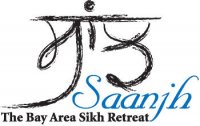
“Saanjh”-the annual Bay Area Sikh Retreat is taking place Thursday, August 27th-Sunday, August 30th at the Monte Toyon campsite near Santa Cruz, California. Share your experiences and connect with other Sikhs through a Guru-inspired sangat. This year’s theme is “Developing a Panthic Vision Towards 2084”. In 2009 we commemorate the 25th anniversary of 1984. When we fast-forward to its centennial where do we want to be as a Panth-a Sikh community? What is our collective vision for 2084? How do we need to develop as individuals and a community in order to heal ourselves and find solutions to our communal problems? Come share your opinions and connect with other concerned Sikhs through a collaborative approach to finding solutions. You will be inspired by diwans, conversations, debates, and laughter. Register by August 3rd to avoid late fees. There is a separate fee schedule for students and professionals. For more information visit www.saanjh.org. If you have any questions, e-mail sawal-jawab@saanjh.org.
As way of background, “Saanjh” began last year by a group of Bay Area Sikhs who were inspired by their personal experiences of engaging with sangats world-wide. They felt there was a need in California to “retreat” from our daily routines into a relaxed space where we could be inspired by our Guru. With this inspiration we could go back to our “real” lives as better engaged Sikhs spiritually, socially, and politically. The focus of the retreat is on learning from our experiences as diverse Sikhs in order to develop a collective vision for our community.
 Throughout the United States, the issue of race and racial profiling has taken center stage – all linked to a local event in Cambridge, MA. It was there, near the Harvard University Campus, that well-known academic, scholar, and public intellectual, Henry Louis Gates Jr. had an altercation with a police officer, Sgt. James Crowley. What may have been a local affair was catapulted to the national stage with Barack Obama weighing in and giving an assessment in favor of Gates, a friend of his.
Throughout the United States, the issue of race and racial profiling has taken center stage – all linked to a local event in Cambridge, MA. It was there, near the Harvard University Campus, that well-known academic, scholar, and public intellectual, Henry Louis Gates Jr. had an altercation with a police officer, Sgt. James Crowley. What may have been a local affair was catapulted to the national stage with Barack Obama weighing in and giving an assessment in favor of Gates, a friend of his.
The reactions that have followed in the last week have been swift and rather predictable. “Conservatives” have come to the defense of a hardworking cop, who was just trying to do his job, while Gates is a pampered black elitist, always ready to “play the race card”; “liberals” concerned with civil rights see Gates as another victim of racial profiling. Some have sought a deeper analysis about structural problems in the society we live.
A few articles have delved into understanding the events from both protagonists’ perspective:
Should Gates have realized that you can’t antagonize the police? Should Crowley have understood what it means to suspect a black man of breaking into his own home? Arguments will persist for years.[link]
Still, I believe whatever the merits of the individual case, Sikhs should be paying special attention to the ongoing story.
A nice piece in the Columbia Journalist discusses the challenges incurred by young Sikh men and women as they navigate through their adolescent years. The article tells us of two friends, Sonu Singh and Manjinder Singh, who have bonded over their love of hip-hop, video games, and (of course) girls. However, as the article notes, what sets these friends apart is the fact that while Manjinder chooses to keep his kesh, Sonu plans to grow his hair and wear a pagh later on in life.
Sonu and Manjinder embody a larger tension within the Sikh community – the internal dilemma among children to remain true to their faith while still fitting in with their peers. After the terrorist attacks of September 11, 2001, some Sikhs simply do not want to stand out. Incidents of harassment and discrimination towards Sikhs students have increased dramatically since then…
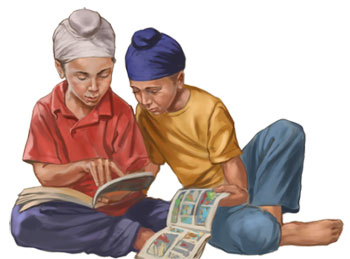 The article talks about the various cases of harassment and bullying which have taken place in New York City schools. The Sikh Coalition has stated that almost half of students who wear paghs have experienced physical violence in school. Yes, half! While bullying affects children of all ethnic groups, it is clear that Sikh children feel especially vulnerable. In addition, many young Sikh children don’t feel that they are adequately equipped to deal with harassment targeted at their physical appearance.
The article talks about the various cases of harassment and bullying which have taken place in New York City schools. The Sikh Coalition has stated that almost half of students who wear paghs have experienced physical violence in school. Yes, half! While bullying affects children of all ethnic groups, it is clear that Sikh children feel especially vulnerable. In addition, many young Sikh children don’t feel that they are adequately equipped to deal with harassment targeted at their physical appearance.
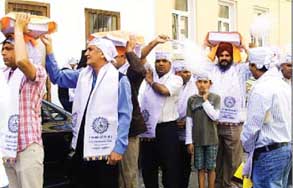 Beyond brown or white Sikhs, beyond various caste Sikhs, when and how do we come together as Sikhs? Is the ‘jahaaz’ that is Guru Nanak’s Naam large enough to carry us all, or with a narrow set of doxies and praxis do we restrict those that can enter.
Beyond brown or white Sikhs, beyond various caste Sikhs, when and how do we come together as Sikhs? Is the ‘jahaaz’ that is Guru Nanak’s Naam large enough to carry us all, or with a narrow set of doxies and praxis do we restrict those that can enter.
Despite the various attacks on the Singh Sabha movement for only promoting Khalsa hegemony and other spurious slanders by neo-Sanatans, post-colonialists (I am reminded of a professor that once told me that he would only become a post-colonialist, when colonialism ends) attempting to form neo-Brahman ‘intelligentsias’, those that believe they ‘own’ the Sikh identity, some Hindu chauvinist groups, and various beatniks, the movement was in fact very broad-minded and fought to enlarge the tent that is the Sikh Qaum.
They understood the difference between public and private aspects. In private, people may have their own practices, beliefs, etc. and while the Singh Sabha sought to bring these more in line with the practices and principles of Gurbani, they did allow some diversity in private. In public, we come together and stand by the Panthic rehat maryada.
For many years the Ravidasia, occupied such a place. They had distinct practices in their own places of congregation, but they were part of the larger Sikh Qaum. That was until now.
Early last week, a remarkable thing happened. Sikh children took to NYC streets again- some in strollers- and they were heard.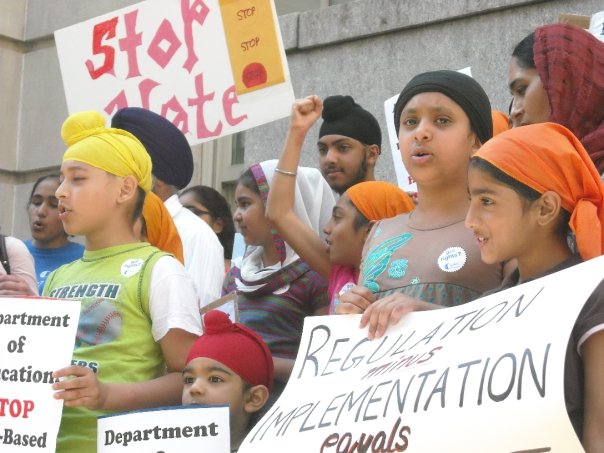
Last fall, the New York Department of Education passed a regulation in response to disturbing findings about the bullying that Sikh children face in schools. The regulation promised to define, track, and prevent bias-based harassment in NYC public schools. So after the first school year in which the regulation was in effect, how did the schools measure up?
The results were made public at a recent press conference by the Sikh Coalition and Sikh youth in NYC in front of the Department of Education’s headquarters. The Sikh Coalition teamed up with area organizations including the Coalition for Asian American Children and Families (CACF) and the Asian American Legal Defense and Education Fund (AALDEF), to release a report card grading the first year of the regulation’s implementation. Speakers at the press conference included representatives from Queens and Brooklyn schools and organizations such as the New York Civil Liberties Union (NYCLU), Desis Rising Up and Moving (DRUM), and Make the Road NY.
Problems remain, the report card shows. Based on the Sikh Coalition’s survey, there was no significant decline in the rate of harassment in the first year of the regulation’s implementation. [pg.9] Perhaps most disturbingly, out of all harassment reported by children, 16% was committed by a school official such as a teacher, school staff member, or security officer. [pg.12] In addition, after 90% of reported incidents of harassment to school officials, the school failed to properly follow protocol for investigation and follow-up. [pg.11]
For the full report card, click here.
We’ve all sat through it before…or…stood through it, that is.
As Anand Sahib ends, we stand for Ardaas and collectively reflect on the lives and accomplishments of the Gurus and the 18th century martyrs who gave their lives to preserve our Sikh way of life. Somewhere in between this reflection, and wishing for “Sarbat da Bhala“, we take a bizarre detour in to the “ins and outs” of our community.” Yes…I am referring to the lengthy list of births, birthdays, graduations, anniversaries and other milestones we find in the middle of our Ardaas.
I’m not sure when this practice started; where a member of the sangat would make an offering to the Gurdwara so an “Ardaas” can be done on their behalf. Birthdays are most common week to week, but I have heard more creative ones – celebrating a new job, new car, first mother’s day, wishing someone well on an upcoming exam, or safe travels for someone’s trip to India. Some even taken advantage of this process, by doing an “Ardaas” on behalf of their business week after week – essentially advertising their local store, while they have the entire community’s ear. I’ve raised this issue to the committee that perhaps there needs to be a better way to handle these “community announcements” rather than during Ardaas…I mean, seconds after we recount the martyrs who were cut limb by limb and scalped, we collectively thank Waheguru for Tinku’s new Benz? It just doesn’t seem right.
Last week, I wrote a wrap-up about the 10th Annual Jakara Movement Conference. Sikh Knowledge, a previously featured artist, wrote his thoughts on his blog.
However, an especially important post was written by Pashaura Singh Dhillon. For those that are regular langa(r)-eaders, then you need no introduction. In a post during last year’s presidential election, I introduced a Fresno Punjabi landmark – one of our many great poets.
At last week’s Jakara Movement Conference, Pashaura Singh delivered a powerful poem at the farewell banquet. On his own blog, he introduces the piece, written with a contemporary problem using a traditional Mirza meter. I quote at length:
I was invited to share a poem I wrote at the closing banquet of Jakara Movement. Jakara began in 2000 with a mission to call the next generation of Sikhs from all places, backgrounds and points of view to reflect on their past and prepare for the future. In 2009, they came together as the next generation of Sikhs to continue the process of empowering, engaging , and educating the Sikh community.
Kanwar Anit Singh Saini (Sikh Knowledge) and Kanwar Singh (Humble the Poet), two Canadian rappers and participants of 2009’s Jakara said it best. “1984 is all around us. It is happening in Rwanda. It is happening in Palestine. We should try to find connections with people who are also victims because then the minority becomes the majority.”
But I was not there to repeat what had already been reported or was going to be reported on this subject. As a poet I wanted to invite them to a different plane, whereby they not only take the message of what happened to the Sikhs 25 years ago but also what is happening all around the world today and how it relates to us all. A big picture where these compounded atrocities and excesses not only of humans on humans that are happening everyday but also collectively of humans on this planet Earth, which threatens its very survival. The victim of human’s inhumanity the Earth pleads with the princess of the Skies whose domain the fugitive from Earth is now so impatient to intrude. Without further adieu, here is “Umber Di Shehzadi De Naa: To the Princess of the Skies”

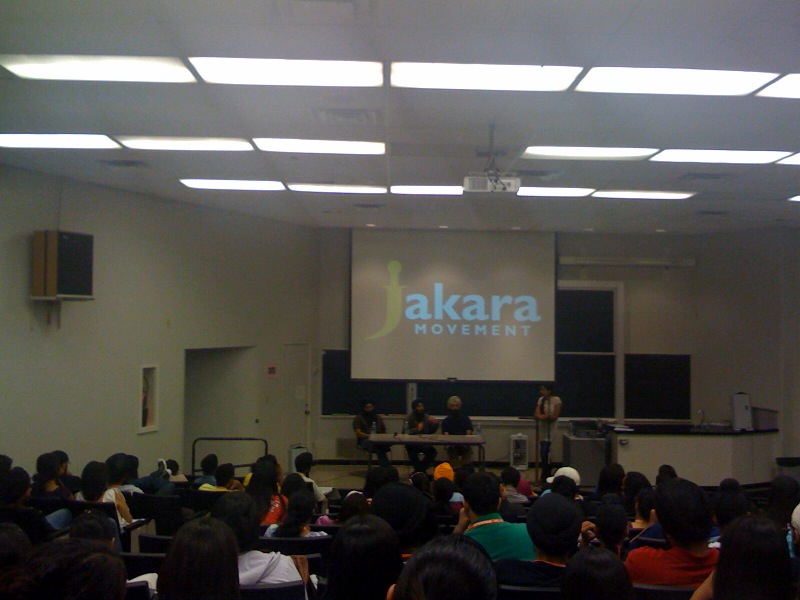 10 years ago the Jakara conference was born;
10 years ago the Jakara conference was born;
5 years ago the Jakara Movement was born.
This year was the 10th annual Jakara Movement conference. This year we Remember 1984.
From remembering the past, reflecting on Gurbani, reconnecting with the voices of the people, rethinking the role of the media, and revering our heroes and sheroes – it was an eventful Friday! Saturday included recognizing the lessons of 1984, reaffirming our commitment to the Sarbat Khalsa and Gurmata tradition of consensus building, recollecting with our brothers and sisters, reacting to their personal histories, responding to the past, and finally realizing a new reality is possible.
From evenings of recreation to days of reflection, the Jakara Movement Conference 2009 aimed to be inspirational, not only for those participating, but for the greater Sikh Qaum as well.
However, merely increasing one’s knowledge about 1984 is not enough. The Jakara Movement is providing avenues to respond and to engage with your community.
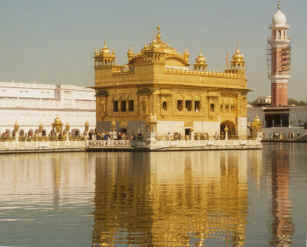 For some Sikhs in Punjab, apparently two Harmandar Sahibs. Or at least that’s the argument between the SGPC and a group of Sikhs. The SGPC argues that a group of Sikhs are building a replica of Harmandar Sahib, and that they stridently oppose any “imitation” gurdwaras (my phrase, not theirs).
For some Sikhs in Punjab, apparently two Harmandar Sahibs. Or at least that’s the argument between the SGPC and a group of Sikhs. The SGPC argues that a group of Sikhs are building a replica of Harmandar Sahib, and that they stridently oppose any “imitation” gurdwaras (my phrase, not theirs).
The Sikhs, who are definitely building a gurdwara (but whether or not it is intended to be a replica is contested), argue that the SGPC is trying to stir up trouble and adopting wedge politics tactics to scramble for power.
At first I read this story and thought to myself, “Wow, that is wacky.” But the longer I’ve reflected on it, the more I have to ask — REALLY???
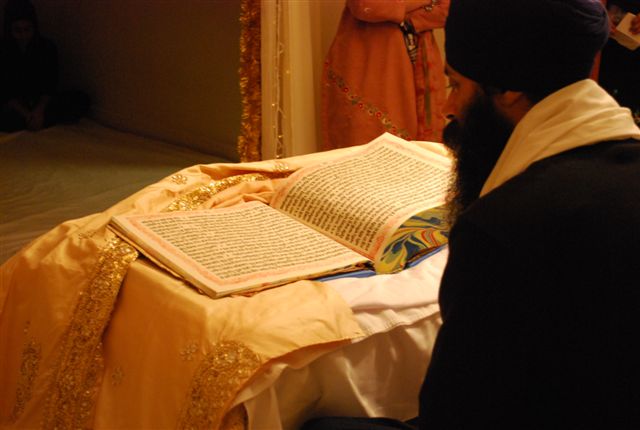 A few weeks back, an article called Outsourcing Prayers [scroll to the bottom], by Khushwant Singh caught my attention. It discussed how people pay big money to religious institutions abroad to carry out services and prayers on their behalf. This “outsourcing” of prayer helps out the “well-to-do” Americans and Europeans who do not have time for worship, while also benefiting cash-starved churches and the local economy of these remote areas. Several religions were mentioned in this article and Sikhs were not spared:
A few weeks back, an article called Outsourcing Prayers [scroll to the bottom], by Khushwant Singh caught my attention. It discussed how people pay big money to religious institutions abroad to carry out services and prayers on their behalf. This “outsourcing” of prayer helps out the “well-to-do” Americans and Europeans who do not have time for worship, while also benefiting cash-starved churches and the local economy of these remote areas. Several religions were mentioned in this article and Sikhs were not spared:
I sought explanation from the head granthi. He told me people from India and abroad sent money for akhand paths to be followed by Guru-ka-langar as thanksgiving or wish fulfillment. I could not comprehend how prayers recited by someone else could benefit a devotee who paid for them.?
There has been much debate in our community on whether paying a professional to do an Akhand Paath on one’s behalf is contradictory to Gurmat. I also remember years ago when the SGPC was “selling” Akhand Paaths on-line. Luckily, outrage from Sikhs all over the world stopped that practice. However, this article got me thinking about Akhand Paaths, and the role it currently plays in our community.
Joint post by Mapleleaf Sikh, Sundari, Jodha, Camille, Phulkari, RP Singh, Reema
It has been 25 years and we remember.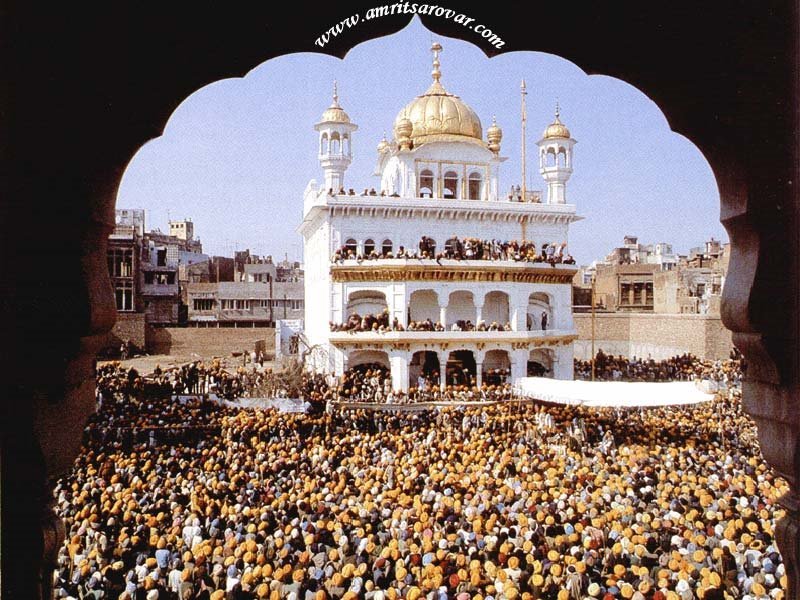
On this day we remember; in this week we remember; in this month we remember; in this year we remember. On June 6th we stopped to remember the recent chapter in the history of the Sikhs.
When the topic of 1984 is brought up, most Sikhs have one of two reactions. For many, it strikes a deep chord. It awakens a memory of what Professor Tatla calls a “critical” event, one of those rare instances that shapes lives far beyond the incident’s physical reach. It is an event that every Sikh knew, even at the time, had marked the fabric of Sikhs’ history and set off a sequence of events that would stay with us indefinitely.
For others, it involves resurrecting the tragic shadow from the past that they would much rather leave behind and forget. They say, “Let’s focus on the future.” “What’s done is done, and we must live in the present and look forward. Memories of the event only serve to create additional hatred and anger.”
We, at TheLangarHall, choose to remember.
We do not hold onto fear, anger, or hatred. We understand that time does not stop. Guru Gobind Singh Ji often spoke in the future tense. We look to the future as well.
However, to look forward, we do not need to forget the past. In Ardaas, along with Asa di Vaar that is to be done as a “community,” we share and take inspiration from Sikh sheroes and heroes.
In order to move forward with dignity, we seek justice and truth, to expose the events of 1984 and state-terrorism in the subsequent decade. We criticize and scrutinize our own roles and failings so that we may learn a lesson from this chapter of our history. We celebrate and decide our own heroes and sheroes, without seeking approval from anyone else.
This is our history. This is our truth. It must be recorded. Atonements and reparations must be made. We will write our own history, unlike many Sikhs in the past. We hold pens and no longer are forced to live in the Lakhi Jungle. We will not let others write our history. It is our history; it is about us, by us, and our perspectives will be heard.
[For background information on events leading up to Operation Bluestar, see chronology and resources on Ensaaf‘s site.]
Below, we share with you, why each of us individually remembers.
 Many eons ago, my friend Mewa Singh wrote:
Many eons ago, my friend Mewa Singh wrote:
Most Sikh organizations’ backbone tend to be its Kaurs.[link]
[As a side note, kaptaan, where did you go?] I definitely second that thought. A common lament that I often hear from some Sikh men is that somehow Sikh women are somehow lacking in terms of their commitment to the faith. I do not subscribe to this theory, and would actually refute it by Mewa Singh’s observation quoted above. By far the majority of the activists that I have ever encountered have all been Kaurs, despite the often blind Sikh organizations. The banal complaints of some Sikh men, for me, are just that – banal complaints.
Still, as an agent of change within the community, I believe a glance at the structural problems within our religious community is warranted. A recent spate of articles has made me wish to visit the issue of female Granthis
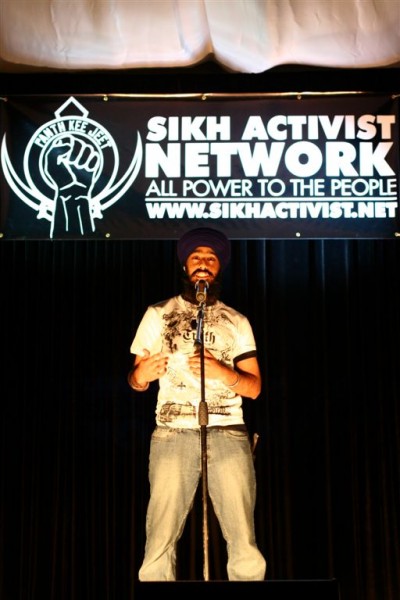
It is often said that a revolution begins not with the sword but with the pen. However, last Friday night in a packed banquet hall in the Toronto suburb of Malton, I witnessed a revolution begin with the microphone.
At an event entitled “When Lions Roar”, fantastically organized by the Sikh Activist Network, one young artist after another got on to the mike and paid homage to the lives destroyed in 1984. I was blown away by the talent and passion displayed by the performers. Through the art of spoken word, music, and action, each of the 26 acts put a different face on the impact of June 1984. They were all unique in their perspective, but all shared one common thread: 1984 is just too important to forget.
Over 1000 people gathered to attend the 4+ hour event. They covered the entire spectrum of Sikh life. This was not your typical retreat and kirtan crowd. In fact, the diversity of performers and audience has challenged me to rethink my stereotypes about who cares about 1984 and the future of the Sikh panth. Individuals that I would have never suspected of having even a passing interest in Sikhi or the Sikh community, would come up to the mike and speak with such energy, insight and emotion. They often reduced me to tears. And most amazing was the fact that almost all of them weren’t even alive in June 1984.
For a thirty-something guy like me who has always considered myself part of the “youth”, it was indeed a little bit humbling to realize that, while I’d probably still be the youngest guy at a Youth Akali Dal meeting, I’m now probably a generation or two above the youngest Sikh leaders. Which means me and my fellow Generation X-ers need to spend less time trying to do it all ourselves, and more time using our resources to enable the next wave of younger Sikhs to establish their own voice and institutions. We were the first generation coming through the diaspora, with little support from our elders. However, we can make it easier on our younger brothers and sisters. We can provide them seed funding to start their dreams, connect them those that can help them along the path, and help coach them through their challenges.
As you’ll see from the videos and photos, the next generation has indeed stepped up, their language of change is hip-hop and I think they’re gonna be alright.
Click through for videos and pictures.
This week I came across a couple of interesting stories out of the UK about how 1984 has since affected Sikhs. BBC Asian Network is currently previewing a radio documentary, hosted by Pops from Tigerstyle, discussing the impact Operation Bluestar has had on British Sikhs. The documentary discusses what impact, if any, 1984 has had on the Sikh conscience and the political activism that emerged. During that year, weekly covers of Des Pardes portrayed pictures of dead Sikhs – images that have stayed with many of us over the years. There existed a sense of hopelessness many Sikhs felt after only reading about and hearing of what was happening in Punjab. As one young Sikh woman states, “a record number of people took Amrit in that year”.
Before 1984 there were fears within the British Sikh community that young Sikhs, in particular, were assimilating into British way of life. A the time what Bluestar did was galvanize the community. .. and generally Sikhs were put on the spot by Operation Bluestar globally and in 1984, in the immediate aftermath, there was a great reassertion of Sikh identity – the visual representation of Sikh identity.
In a Guardian article yesterday, Sunny Hundal discusses how Operation Bluestar and the subsequent events have impacted Sikhs since.
Almost every year groups gather in London to commemorate these events and raise awareness of people still missing or locked up. Sometimes, the Indian flag is torched. In one report produced for the anniversary, the whole episode it is described as the “Sikhs’ Kristallnacht”. But while these facts are well documented and constantly discussed, there is less acknowledgement of how the episode has affected Sikhs since. [link]
He goes on to highlight three ways 1984 is still impacting Sikhs,
In remembrance of the 25th anniversary of the Darbar Sahib attack, I’m re-posting a piece I had written for sikhchic.com‘s “1984 & I” series:
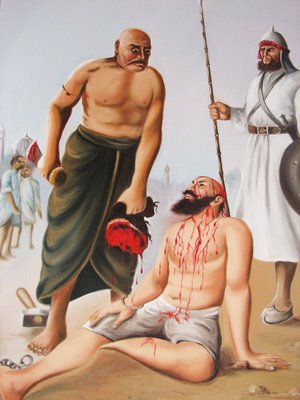
This Is Who We Are
Years ago, I was giving a local church group a tour of our Gurdwara. While I was showing them around the langar hall and explaining the history and significance of langar, I noticed that I was losing my audience. It took me a second to figure it out, but it appeared they were fixated on one of the images on the wall. It was the painting we’ve all seen of Bhai TaruSingh being scalped and blood running down his body. I’m not sure what shocked them more – the graphic painting itself, or the five-year-old boy sitting beneath it, quietly eating his meal.
For just a second, I put myself in their shoes. I looked around the room and saw pictures of Sikh martyrs from the 18th century – a man being boiled alive, a person being sawed in half, two little boys being bricked alive, and an old man with his fingers getting chopped off. And I thought to myself…is this really necessary, the depiction of these scenes in these surroundings?
I started to wonder: are these images really what we want to convey to our visitors? Shouldn’t we find something that depicts universality and love for humanity? Especially after 9/11, shouldn’t we be displaying a softer image of Sikhs? After all, this dining area is a place for us to share a common meal, and little children play down here, for God’s sake! Is this really appropriate?
But then it dawned on me …
This is who we are.
Guest Blogged by Mewa Singh
No, I didn’t actually grow up with Inderjit Bains, but by the end of the post, you’ll get it.
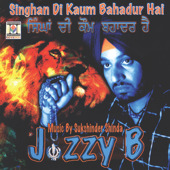 For those that have been following the North American bhangra scene, since its inception (remember, DJ Sunshine, DJ Guru, – I never liked DJ Jiten’s Hindi remixes – and, yes, even DJ Russell Peters), then the name Inderjit Bains needs no introduction.
For those that have been following the North American bhangra scene, since its inception (remember, DJ Sunshine, DJ Guru, – I never liked DJ Jiten’s Hindi remixes – and, yes, even DJ Russell Peters), then the name Inderjit Bains needs no introduction.
In North America, bhangra started with remix DJs in Toronto, but it took Inderjit Singh Bains to help change the scene. It was he, as a pioneer, that helped launch North America’s first true bhangra star – Jazzy B (although at the time, few of us would ever admit to it and spent most of our days hating on Jazzy’s various haircuts on bootleg tape covers).
The trajectory of North American bhangra, influenced in the early 1990s with the explosion of Westcoast gangster rap and especially G-funk, reshaped the global bhangra scene. While UK artists like Apache Indian and Bally Sagoo were doing their own type of hybridity with reggae and bhangra, Inderjit Bains was successful in bridging a ‘folk sound’ with hip-hop influenced bhangra beats. He found a formula. After the success of Jazzy B, he helped launch the career of Central California’s Bhinda Jatt (Bhinda took the early 90s gangster image, much further than Jazzy did, during that time), Madan Maddi and even Sukhshinder Shinda.
My fellow langa(w)r-iter wrote about his latest project – working with a kindred social activist spirit in the artist Taranampreet on her song “Teri Meri Bas: Sat Sri Akal”. While the focus on that post was on the role play women play men’s upkeep of the Sikh appearance (will we ever get a song on the role men play on the women’s upkeep of the Sikh appearance?), I want to take a bit of a different angle.
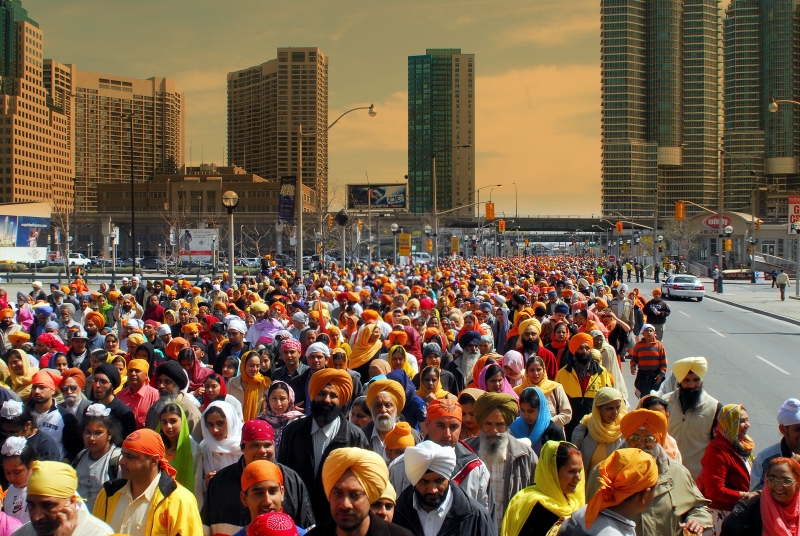 Years ago, I attended a Sikh retreat far from home – outside of the United States and outside of my “normal crowd.” It was interesting to experience Sikh life in a different country…and I think Bono had it right when he said, “We are one, but we’re not the same.”
Years ago, I attended a Sikh retreat far from home – outside of the United States and outside of my “normal crowd.” It was interesting to experience Sikh life in a different country…and I think Bono had it right when he said, “We are one, but we’re not the same.”
The first morning we all woke up at Amrit Vela and joined in Nit-Nem and Shabad Keertan. Everybody was in to it and nobody seemed distracted. It was one of those powerful “Sangat” experiences where you lose yourself and become part of the whole. I loved it! I was so energized after that Deevan and was excited for all the weekend’s activities to come…then came breakfast.
(more…)
He locked the washroom door, unravelled the nine-metre turban, took a pair of scissors and started cutting. Ten minutes later, three feet of hair lay in a pile and Charanbir Singh sat down and cried.
Outside, his parents and grandmother were in tears. Two friends persuaded him to come out, but Charanbir, his head wrapped in a towel, rushed to his room.
That was a year ago. Charanbir, now 17, still shudders at the memory. “I had to cut my hair.” (Link)
One of ironies of life in the 21st century western world is that despite an unparalleled degree of freedom of religion, the majority of people seem to be opting for freedom from religion.
Last week, Raveena Aulakh, a reporter from the Toronto Star, put a Canadian twist on the worldwide issue of apostasy amongst Sikh Youth.
Sikhism dates back to 15th-century India. Adherents are required to not cut their hair, considered a visible testament to their connection with their creator. The turban was adopted to manage long hair and make Sikhs easily identifiable.
For many young men in Greater Toronto, that is the problem: They don’t want to stand out.
Like other new or second-generation immigrants, many Sikh youngsters are desperate to fit in with the school crowd, while others complain of racism because they wear the turban. Add to that cultural influences, peer pressure and the desire to assimilate.
The end result? Many youngsters cut their hair, leading to family friction and, in some cases, lasting estrangement.
As a counterpoint, in the article and video above, Pardeep Singh Nagra (of boxing fame) presents his thoughts on why he’s decided to keep his hair.
Fear & Guilt
I’ve often wondered why so many Sikh youth keep their hair through high school but cut it as soon as they feel free from their parent’s control? From my perspective I see this as symptomatic of a great challenge facing Sikhs around the world today. Somehow, someway, we have fallen into the trap of pushing Sikhi to the next generation with fear and guilt, rather than sharing Sikhi through love.
Take your typical Sikh family; actually take mine. My now 25 year old cousin in Punjab had wanted to cut his hair since he was a teenager but two things stopped him. He was afraid that if he cut his hair his dad would beat him and then disown him. Secondly, he knew that if he did get a haircut and shave he wouldn’t be able to look his crying mom in the eye.
Unfortunately, there was little positive reinforcement around Sikhi in his life. Sure there was Sikhi by osmosis: visiting Gurdwaras, gurbani playing in the background, the odd sakhi told by our visiting grandfather. However, my cousin had little exposure to the aspects of Sikhi (nitnem, kirtan, seva, simran) that would have connected him with his faith on a deeper level. Most of the discussions with his parents were a flavour of the famous Goodness Gracious Me clip. So not surprisingly, upon entering college, he too cut his hair. And sure enough, he became our family’s black sheep, making a kid with already low self-esteem, feel even worse.
My last post was about what we knew at that time. Since then, there are new updates.
After the attack in the Vienna temple (actually a dera of the Sach Khand group), there are news confirmations that Sant Rama Nand has passed away from his injuries, while the Dera head Niranjan Das is in stable condition.
There are also reports of violence in Punjab. IBN live reports the death of 2 people in the Doaba region and also one should note that it seems that the army has been called in to parts of Punjab.
One person was killed and four others were injured as Army jawans opened fire in Lambra village, 30 kms from Jalandhar. Another person was killed after the police opened fire on protesters at Jalandhar Cantonment railway station. [link]
In some ways I believe that this is a tragedy of the 80s and 90s.
Thematically Sikh paintings are rare. Thus, when I came across the paintings below, I thought I should share. The oil paintings below are the work of Jaswant Singh Zafar. He’s a poet, photographer, and painter in his free time and an engineer in Ludhiana by day. This year, he’s spending his free time creating a series of paintings under the theme of ‘Gurbani.’ The paintings completed thus far weave the mool mantar through various aspects of nature, shapes, and other backgrounds.
At the end of the year, the series will be in an exhibition at the Artmosphere Gallery in Ludhiana. Artmosphere was created to provide a platform for budding artists in Ludhiana and Punjab such as Jaswant Singh Zafar. Such an endeavor cheers me and gives hope that the visual arts scene there is growing.

I appreciate these paintings because they provide some insight into the art scene in Punjab- an example of what’s happening there. More works from this series can be found here.
